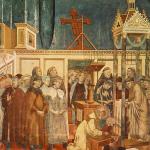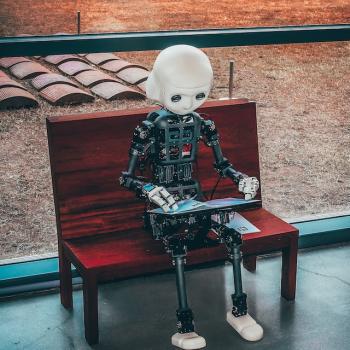Last summer, two people in my life got diagnosed with terminal cancer.
On the weekend after Thanksgiving – the feast of Christ the King – one of them made the transition from curative to palliative care. After about two months of chemotherapy, he contracted COVID-19 last October. Though he recovered, he was left too weak to withstand more chemo. He spent much of November in a rehab facility trying to regain strength to continue the treatment. But at Thanksgiving he made a decision: to stop treatment and come home.
D, who lives in my hometown of Buffalo, NY, is very close to my family and me. His daughters are my childhood best friends – we met in second grade, and we are still friends three decades later. My family and his have been close since 1990, and he has been like an uncle to me. He is my father’s last remaining close friend…and actually, my father is his.
This situation has cast a strange shadow over this season of light. Advent is a season of peaceful hopeful, joyous expectation and anticipation. And yet, the light of the season is juxtaposed to the very real presence of death. The days are growing shorter; tomorrow, the winter solstice in the Northern Hemisphere, is the shortest day of the year. For people who suffer from seasonal affective disorder, it is not an easy time. As such, it is no coincidence that so many cultures and religions hold festivals of light during this time.
As Christians, we believe that God was and is incarnated in the person of Jesus. We believe that God became human and shared many of our human experiences: birth, a troubled childhood against the backdrop of forced migration and exile, an adult ministry that involved eating and drinking with the marginalized and laying hands on the sick, and ultimately, physical suffering and death. We also believe that Jesus transcended these bodily limits through the miracle of the Resurrection – but not without first experiencing death. “Truly I tell you, unless a grain of wheat falls to the ground and dies, it remains by itself. But if it dies, it produces much fruit” (John 12:24).
In recent years, many have commented on how contemporary Western culture – particularly in the United States of America — has led to an alienation from the processes of death and dying. Ten years ago, renowned surgeon Atul Gawande published Being Mortal: Medicine and What Matters in the End, which sought to change the conversation around death and dying, arguing for the need to focus on human dignity and quality of life in the face of old age and death rather than denial. In 2017, palliative care physician Kathryn Mannix published With the End in Mind, a book aimed at changing the ways we think about death and dying. In the introduction, she argues for the need for better conversations around life’s inevitable end:
Technology is deployed in a new deathbed ritual that is the triumph of denial over experience. The death rate remains 100 per cent, and the pattern of the final days, and the way we actually die, are unchanged. What is different is that we have lost the familiarity we once had with that process, and we have lost the vocabulary and etiquette that served us so well in past times, when death was acknowledged to be inevitable. Instead of dying in a dear and familiar room with people we love around us, we now die in ambulances and emergency rooms and intensive care units, our loved ones separated from us by the machinery of life preservation.
Ever more frequently, many people in Western societies –
including Catholics – are seeking to enliven and rehumanize the conversations around death and dying. Death cafes, death doulas, and organizations like the Threshold Choir – groups of women who sing simple, comforting songs for people who are dying – have added their approaches to a growing movement to restore a more widespread acceptance of natural death as a part of life, with all of the dignity that this entails.
When D made the transition from curative care in a rehabilitation facility to hospice care at home, many of the people around him thought he would not last long. Panicking, I rushed off from my current home of Pittsburgh to my original home of Buffalo as quickly as soon as classes ended at the college where I teach. But, as experts like Gawande and Mannix have experienced, the transition home boosted his morale and improved his quality of life. Of course, he is sad. Of course, he is afraid. But during the time I’ve spent with him, I have seen D continuing to be the person he has always been: a gentle, caring man with a lively sense of humor.
During these Advent weeks, all D has wanted is the presence and accompaniment of close family and friends. A week and a half ago, his wife, daughter, and nephew – as well as my parents and I – gathered around the television to watch our beloved Buffalo Bills defeat Kansas City. One day, we watched an episode of The Bold and the Beautiful – a soap opera that my mother, grandmother and I were all addicted to in the 90’s and hadn’t seen in at least twenty years. D informed me that Ridge still has never made up his mind between Taylor and Brooke.
A few years ago, while living in Iowa, I briefly sang with a group of women inspired by the Threshold Choir – women who sing simple songs of comfort for people who are dying, giving birth, moving, starting a new job, or undergoing any other life transitions. Remembering some of the songs, I spent several days trying to round someone up in Buffalo to sing with me (these songs are largely rounds and depend on harmonies, so singing them alone doesn’t have the same effect).
The trouble is I’ve not actually lived in Buffalo full-time for many years, and so rounding someone up was not easy. Through the magic of social media, I reached out to an old high school and college classmate whom I once sang in a choir with – someone I’d not seen in twenty years, but whose social media posts revealed her poignant experiences of caring for her father with Alzheimer’s Disease. She immediately said yes, within days we were together in his living room, singing a Navajo prayer: “Peace before you, peace behind you, peace under your feet. Peace within you, peace over you, let all around you be peace.”
The season of Advent is a time when we celebrate peace, hope, joy, and love amid darkness. Over the past weeks, D has demonstrated these virtues every single day. His desire to be present to those around him, to celebrate and enjoy life right to the end has been an inspiration and a lesson. He has modeled that, when faced with dying, fear and pain – while inevitably present – do not need to be the emotions that dominate. Each Sunday, as another candle on the Advent wreath has been lit, D and the people around him have been blessed by the graces of the season.
Due to various family conflicts, Christmas is traditionally not my favorite time of the year –
a common experience for many of us. This year, however, my family and D’s will be celebrating it together. Just a few weeks ago, I didn’t think he’d make it this far – and of course, a lot can happen in Advent’s final days. But no matter what, I am truly grateful for the tremendous gift I’ve been given this season: the sacred experience of accompanying a loved one from this life to the next. During the past three weeks, I have both given and received tremendous mercy. Wherever you are, whatever hardships you are facing, my Christmas wish is that you might give and receive the same.













